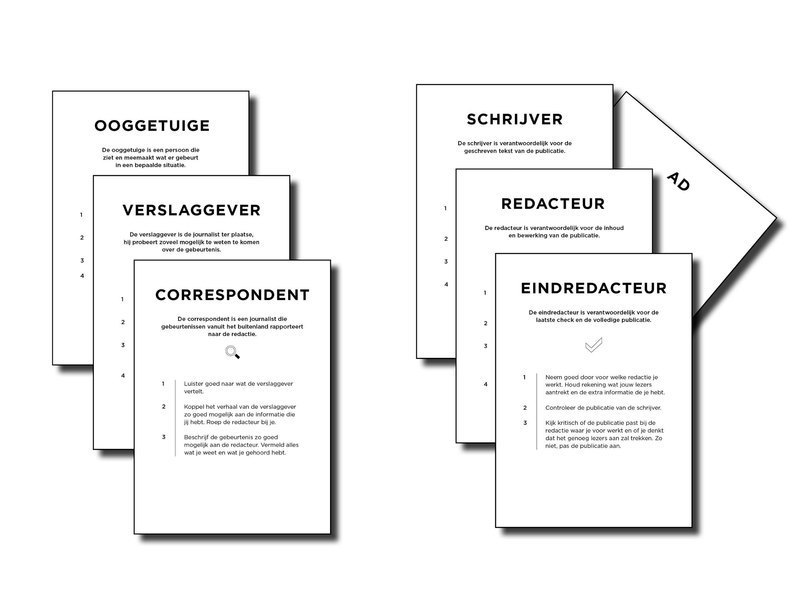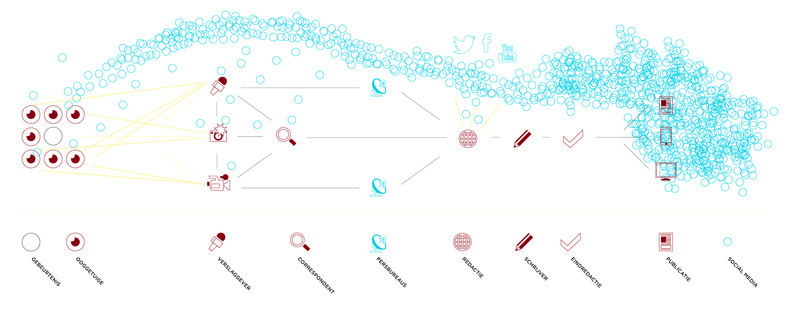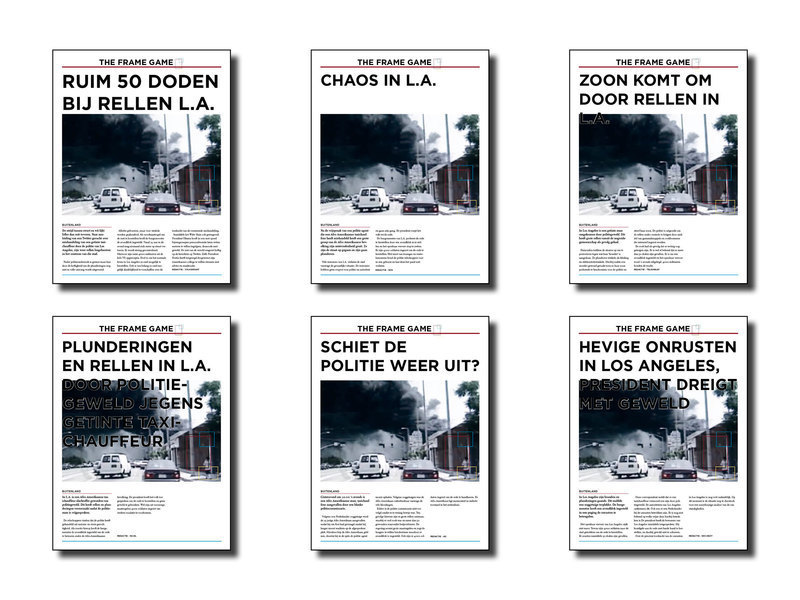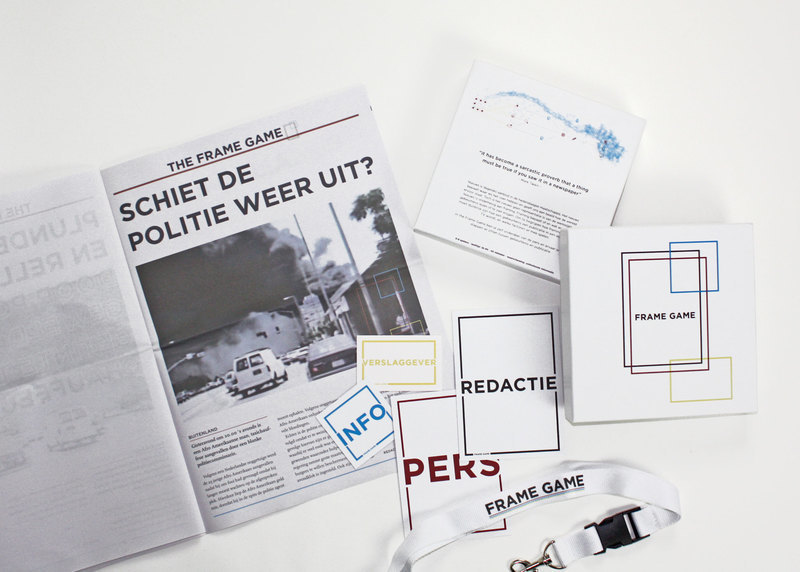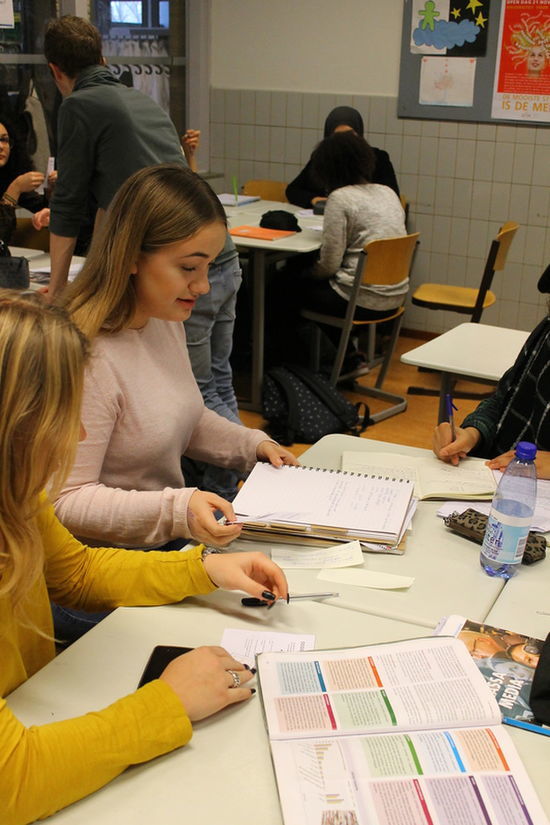Difference between revisions of "The Frame Game"
Rümeysa Önal (talk | contribs) |
|||
| (21 intermediate revisions by 6 users not shown) | |||
| Line 1: | Line 1: | ||
| − | + | {{Article | |
| + | |Subtitle=Experience firsthand how framing in news media works | ||
| + | |Image=Spelkaarten.jpg | ||
| + | |Caption=The card deck | ||
| + | |Summary=<small>A Project by Lotte Biesheuvel</small> | ||
| − | + | The news is omnipresent in our daily lives. We consume it from early morning until evening, in all kinds of ways, through TV, newspapers, internet, telephones and radio. It determines what we talk about and how we view the world. Still, most people are not aware of the fact that the news isn’t a representation of the truth. That’s nothing new, as Mark Twain noted already in 1873: ‘it has become a sarcastic proverb that a thing must be true if you saw it in a newspaper’. The instant flow of information does not help to challenge people to think about the complexity of the subjects in the news. Twitter, Facebook and other media that vent our opinions only encourage immediate and explicit opinions. I soon discovered that if I wanted people to experience framing in news media, I should explore the source of framing and comprehend the system of the news media. Consequently, for my graduation thesis and project I asked myself the question: How do I stimulate awareness among news consumers aged 18 to 45 age regarding framing in new media? | |
| + | |Article===Planned behaviour theory== | ||
| + | In previous research I developed an action scheme about how the process of awareness works. The action scheme is based upon the planned behaviour theory of Fishbein and Azjen as well as different gamification techniques. According to these authors, behaviour consists of three components; perceived behavioural control, propositional attitude, and perception of the social norm. These three components form the behavioural intention that leads to behaviour. If you are able to influence these, then you can influence behaviour. Regular behaviour can be found in perceived behavioural control: as you do something more often, you become increasingly convinced that you’re capable of doing it. The perception of the social norm has much to do with the communication or the common practice in your environment. Propositional attitude is very mutable and hard to measure, but when a person cares a lot about something, his or her propositional attitude will be very strong towards that something. Based on the above information, I have divided the process of awareness into five steps. | ||
| − | + | '''Step 1 :''' New perspectives. Access to new and transparent information. | |
| − | |||
| − | |||
| − | + | '''Step 2 :''' Experiencing the value of this information and creating a new frame with this information. This new frame won’t be the same for everyone because everyone has their own unique frame as well. | |
| − | Step 2 : | ||
| − | |||
| − | |||
| − | |||
| − | + | ''Step 3 :''' Applying this new frame | |
| − | + | '''Step 4 :''' The reflection on the experience of the application of this new frame. You reflect whether this experience is positive or negative and how this can further influence your daily life. | |
| − | Designing this action scheme and using it as my tool is not the thing that defines me as a social designer. However, | + | '''Step 5 :''' The repetition of this application. You apply this to your daily living habits. You receive an intrinsic reward because you have made a discovery and gained more knowledge. This will motivate you to repeat step 1. |
| + | |||
| + | == Promoting awareness of framing == | ||
| + | In previous projects, I discovered that new perspectives and reflection are the two most important parts of this process. They have the most impact on awareness. Designing this action scheme and using it as my tool is not the thing that defines me as a social designer. However, one thing that does define me is the tool’s intention to change behaviour in a structural way. Framing is a form of priming, a form of unintentional influence. The human brain is a very associative network. For example, a person who perceives the word as ‘round’ will recognise the word ‘ball’ slightly faster. This happens because round and ball are closely associated in memory. For instance, when news media talk about refugees, the words they use have a lot of negative connotations. And so these will be closely associated in memory. And this in turn has a lot of influence on a person’s judgemental skills. If the news consumer is aware of framing in news media, she/he will be more critical towards the significance of the news. And she/he might develop a more nuanced opinion about complex issues. | ||
| − | == | + | == Analysis of the framing experience == |
| + | News is subject to framing, because of the many different steps between ‘the event’ and the publication, the different people that are involved in every step, and the goals these people pursue. It often starts with an eyewitness. In the process towards publication, she/he is the one closest to the incident but nevertheless, she/he experiences it from her/his own perspective. She/he will probably know some of the background of the incident but most of the time not all of it. She/he will respond to it very intuitively. The reporter, often a local journalist, will investigate the incident, talk to eyewitnesses and try to figure out the cause. She/he is in contact with the correspondent. The correspondent usually isn’t anywhere near the incident, she/he could even be working from a neighbouring country. Her/his job is to research the background of the incident and put it in a clarifying context. She/he reports to the editorial room of the news service she/he is working for. The editorial room doesn’t only get information from the correspondent but also from different press agencies and through social media, where an incident can be online long before it has reached the news media. This information can also be used in the final publication. Often, the opinion of a social media user is presented as the public opinion, which can lead to a new and different perspective. The editorial room has to make decisions concerning the publication by means of other news channels, public opinions, and other events occurring that same day. The editorial room also has to take into account the fact that it has to sell the story to its readers. The writer of the editorial room has to make sure the story covers the right amount of words and meets the intentions of the editorial room. Also, the headline should be catchy and attract the reader’s attention. Briefly before the publication, the editor-in-chief performs a final review to check if the article requires small adjustments in the publication or if it needs to be rewritten. Sometimes there isn’t enough space for the publication due to other important news and the publication needs to be condensed. A lot of information gets lost in this process due to framing. By understanding the process, it becomes clear how framing works. It happens both consciously and unconsciously. The eyewitness, reporter and correspondent are unconsciously framing the incident; their mental representations, simplifications and interpretations influence the way they cover the incident and how they communicate it. The editorial room, the writer and the editor-in-chief are consciously framing the incident by deliberately simplifying it and manoeuvring it towards the wishes of the news consumer. | ||
| − | |||
| − | + | [[File:Visual.jpg|center|A simplified infographic of how an event becomes a publication]] | |
| − | + | == Gamification == | |
| + | After understanding how the news media work, I was able to simplify these systems. The simplified systems seemed to provide the perfect basis for a game. By experiencing the system through a game, the players are able to feel how difficult it is to avoid framing. When I developed these simplified news media systems into a game, I constantly put my work up to test. As soon as I had a first version of the game, I organised a game night with my friends and asked them to play the game and to be as critical as possible of the game system, the subject matter and the playability. I learned that I still had to kill a lot of darlings, especially concerning the design: the players should be able to understand and experience the main issues the game addresses. | ||
| − | + | Designing a game is something very different from designing a poster for example. It is much more about designing a working system everybody understands, but also about designing an experience that is unique for each individual. So visual aesthetics were not my concern in designing the game, until the very end. By collecting the players’ feedback after each test version, I was able to fine-tune the game repeatedly. Creating the project wasn’t possible without the cooperation of the target group. And this is another thing that defines me as a social designer. | |
| − | |||
| − | + | == The Fame Game prototype == | |
| + | The first prototype of The Frame Game offers these new perspectives and reflections. In the game, people play an element of the news process, and in this way they discover how framing works. The Frame Game is loosely based on a children’s game, in which the players whisper a sentence in each other’s ear and the last player ends up with a completely different sentence than the start sentence. In The Frame Game, the players are each assigned a different role, from eyewitness to editor-in-chief. The eyewitness experiences an incident (a short video), passes this on to the reporter, and so on, until the editor-in-chief presents the publication. Each player has her/his own information and knows exactly what to do. | ||
| + | After testing the game a couple of times and fine-tuning the design details, I started collecting the publications. Each group played using the same incident but with different editorial rooms. Interestingly enough, the publications were quite different in tone of voice; some were very accurate regarding the given information, whereas others were highly exaggerated. The game itself provides new perspectives and insights for the players; they experience how easily words can be twisted, how interpretations can mislead, and how editorial rooms make decisions. The reflection that follows is evident, because the group always consists of more than 5 players, who will share their feelings on the game and will connect this to the real world. To stimulate this component, the game is played based on an incident that is closely connected to recent incidents. The game is played with a video and information about the 1993 Rodney King Riots. Players don’t recognise the video as part of the Rodney King Riots, but at the end of the game they can make the connection between this game, the Riots in 1993 and recent events. | ||
| − | + | [[File:Spelkaarten.jpg|enter|The playing cards]] | |
| − | + | [[File:Uitslagen.jpg|enter|The different publications of one event.]] | |
| − | |||
| − | |||
| − | |||
| − | |||
| − | [[File: | ||
| − | |||
| − | |||
| − | |||
| − | [[File:Uitslagen.jpg|The different publications of one event.]] | ||
== Next steps of the Frame Game == | == Next steps of the Frame Game == | ||
| + | The prototype of the Frame Game was very successful and received a great deal of recognition. The reactions of the players were very enthusiastic and they said it opened their eyes in certain ways. The research paper received a nomination for the WdKA research prize, and the Frame Game won the ‘Drempelprijs’ (Threshold Award) for best graduation work in Social Practices. The Frame Game seems to be very suitable to social science education in high schools. Currently I’m working with Marieke Veere Vonk from Studio Harten Aas (‘Ace of Hearts’) in testing the Frame Game in high schools. Already we’ve learned that playing the Game in a classroom requires different conditions, such as more extensive explanations. We’re hoping to find a sponsor or a publisher to make the Frame Game available to the public. We’re also looking for options to provide the Frame Game with a digital component, which makes it easier to play and allows it to be more directly focused on the immediate news media environment. | ||
| − | + | [[File:Theframegame.jpg|enter|Theframegame.jpg]] | |
| − | + | [[File:Frame game in klas.jpeg|The Frame Game|center|550px]] | |
| − | |||
| − | |||
| − | |||
| − | |||
| − | [[File: | ||
| − | + | == Discussion == | |
| + | The Frame Game is a recent example of promising concepts, products and services developed by Graduates of the WdKA. It is a privilege that we are able to annually present the Drempelprijs (Threshold Award) in collaboration with the Municipality of Rotterdam. This certainly provides welcome support for such initiatives, however it is usually not enough to further develop a good plan after the study. How can the WdKA and its network of partners better support its alumni in this respect? We would like to learn from other art and design schools, as well as from our own network of alumni and partners in society, how we can improve this aspect. | ||
| − | [[ | + | ''This final exam project was developed within the Gamification department (Social Practice @ WdKA) Tutor: [[User:Bruno_Setola|Bruno Setola]]'' |
| − | + | }} | |
| − | + | {{Links external | |
| − | + | |link=www.theframegame.nl | |
| − | + | |displaytext=The Frame Game | |
| − | + | }} | |
| + | {{Category selector | ||
| + | |Category=Gamification | ||
| + | }} | ||
| + | {{Category selector | ||
| + | |Category=Empowerment | ||
| + | }} | ||
| + | {{Category selector | ||
| + | |Category=Media | ||
| + | }} | ||
| + | {{Category selector | ||
| + | |Category=Graphic Design | ||
| + | }} | ||
| + | {{Category selector | ||
| + | |Category=Representation | ||
| + | }} | ||
| + | {{Category selector | ||
| + | |Category=Reframing | ||
| + | }} | ||
| + | {{Articles more}} | ||
Latest revision as of 21:24, 30 October 2018
Planned behaviour theory
In previous research I developed an action scheme about how the process of awareness works. The action scheme is based upon the planned behaviour theory of Fishbein and Azjen as well as different gamification techniques. According to these authors, behaviour consists of three components; perceived behavioural control, propositional attitude, and perception of the social norm. These three components form the behavioural intention that leads to behaviour. If you are able to influence these, then you can influence behaviour. Regular behaviour can be found in perceived behavioural control: as you do something more often, you become increasingly convinced that you’re capable of doing it. The perception of the social norm has much to do with the communication or the common practice in your environment. Propositional attitude is very mutable and hard to measure, but when a person cares a lot about something, his or her propositional attitude will be very strong towards that something. Based on the above information, I have divided the process of awareness into five steps.
Step 1 : New perspectives. Access to new and transparent information.
Step 2 : Experiencing the value of this information and creating a new frame with this information. This new frame won’t be the same for everyone because everyone has their own unique frame as well.
Step 3 :' Applying this new frame
Step 4 : The reflection on the experience of the application of this new frame. You reflect whether this experience is positive or negative and how this can further influence your daily life.
Step 5 : The repetition of this application. You apply this to your daily living habits. You receive an intrinsic reward because you have made a discovery and gained more knowledge. This will motivate you to repeat step 1.
Promoting awareness of framing
In previous projects, I discovered that new perspectives and reflection are the two most important parts of this process. They have the most impact on awareness. Designing this action scheme and using it as my tool is not the thing that defines me as a social designer. However, one thing that does define me is the tool’s intention to change behaviour in a structural way. Framing is a form of priming, a form of unintentional influence. The human brain is a very associative network. For example, a person who perceives the word as ‘round’ will recognise the word ‘ball’ slightly faster. This happens because round and ball are closely associated in memory. For instance, when news media talk about refugees, the words they use have a lot of negative connotations. And so these will be closely associated in memory. And this in turn has a lot of influence on a person’s judgemental skills. If the news consumer is aware of framing in news media, she/he will be more critical towards the significance of the news. And she/he might develop a more nuanced opinion about complex issues.
Analysis of the framing experience
News is subject to framing, because of the many different steps between ‘the event’ and the publication, the different people that are involved in every step, and the goals these people pursue. It often starts with an eyewitness. In the process towards publication, she/he is the one closest to the incident but nevertheless, she/he experiences it from her/his own perspective. She/he will probably know some of the background of the incident but most of the time not all of it. She/he will respond to it very intuitively. The reporter, often a local journalist, will investigate the incident, talk to eyewitnesses and try to figure out the cause. She/he is in contact with the correspondent. The correspondent usually isn’t anywhere near the incident, she/he could even be working from a neighbouring country. Her/his job is to research the background of the incident and put it in a clarifying context. She/he reports to the editorial room of the news service she/he is working for. The editorial room doesn’t only get information from the correspondent but also from different press agencies and through social media, where an incident can be online long before it has reached the news media. This information can also be used in the final publication. Often, the opinion of a social media user is presented as the public opinion, which can lead to a new and different perspective. The editorial room has to make decisions concerning the publication by means of other news channels, public opinions, and other events occurring that same day. The editorial room also has to take into account the fact that it has to sell the story to its readers. The writer of the editorial room has to make sure the story covers the right amount of words and meets the intentions of the editorial room. Also, the headline should be catchy and attract the reader’s attention. Briefly before the publication, the editor-in-chief performs a final review to check if the article requires small adjustments in the publication or if it needs to be rewritten. Sometimes there isn’t enough space for the publication due to other important news and the publication needs to be condensed. A lot of information gets lost in this process due to framing. By understanding the process, it becomes clear how framing works. It happens both consciously and unconsciously. The eyewitness, reporter and correspondent are unconsciously framing the incident; their mental representations, simplifications and interpretations influence the way they cover the incident and how they communicate it. The editorial room, the writer and the editor-in-chief are consciously framing the incident by deliberately simplifying it and manoeuvring it towards the wishes of the news consumer.
Gamification
After understanding how the news media work, I was able to simplify these systems. The simplified systems seemed to provide the perfect basis for a game. By experiencing the system through a game, the players are able to feel how difficult it is to avoid framing. When I developed these simplified news media systems into a game, I constantly put my work up to test. As soon as I had a first version of the game, I organised a game night with my friends and asked them to play the game and to be as critical as possible of the game system, the subject matter and the playability. I learned that I still had to kill a lot of darlings, especially concerning the design: the players should be able to understand and experience the main issues the game addresses.
Designing a game is something very different from designing a poster for example. It is much more about designing a working system everybody understands, but also about designing an experience that is unique for each individual. So visual aesthetics were not my concern in designing the game, until the very end. By collecting the players’ feedback after each test version, I was able to fine-tune the game repeatedly. Creating the project wasn’t possible without the cooperation of the target group. And this is another thing that defines me as a social designer.
The Fame Game prototype
The first prototype of The Frame Game offers these new perspectives and reflections. In the game, people play an element of the news process, and in this way they discover how framing works. The Frame Game is loosely based on a children’s game, in which the players whisper a sentence in each other’s ear and the last player ends up with a completely different sentence than the start sentence. In The Frame Game, the players are each assigned a different role, from eyewitness to editor-in-chief. The eyewitness experiences an incident (a short video), passes this on to the reporter, and so on, until the editor-in-chief presents the publication. Each player has her/his own information and knows exactly what to do. After testing the game a couple of times and fine-tuning the design details, I started collecting the publications. Each group played using the same incident but with different editorial rooms. Interestingly enough, the publications were quite different in tone of voice; some were very accurate regarding the given information, whereas others were highly exaggerated. The game itself provides new perspectives and insights for the players; they experience how easily words can be twisted, how interpretations can mislead, and how editorial rooms make decisions. The reflection that follows is evident, because the group always consists of more than 5 players, who will share their feelings on the game and will connect this to the real world. To stimulate this component, the game is played based on an incident that is closely connected to recent incidents. The game is played with a video and information about the 1993 Rodney King Riots. Players don’t recognise the video as part of the Rodney King Riots, but at the end of the game they can make the connection between this game, the Riots in 1993 and recent events.
Next steps of the Frame Game
The prototype of the Frame Game was very successful and received a great deal of recognition. The reactions of the players were very enthusiastic and they said it opened their eyes in certain ways. The research paper received a nomination for the WdKA research prize, and the Frame Game won the ‘Drempelprijs’ (Threshold Award) for best graduation work in Social Practices. The Frame Game seems to be very suitable to social science education in high schools. Currently I’m working with Marieke Veere Vonk from Studio Harten Aas (‘Ace of Hearts’) in testing the Frame Game in high schools. Already we’ve learned that playing the Game in a classroom requires different conditions, such as more extensive explanations. We’re hoping to find a sponsor or a publisher to make the Frame Game available to the public. We’re also looking for options to provide the Frame Game with a digital component, which makes it easier to play and allows it to be more directly focused on the immediate news media environment.
Discussion
The Frame Game is a recent example of promising concepts, products and services developed by Graduates of the WdKA. It is a privilege that we are able to annually present the Drempelprijs (Threshold Award) in collaboration with the Municipality of Rotterdam. This certainly provides welcome support for such initiatives, however it is usually not enough to further develop a good plan after the study. How can the WdKA and its network of partners better support its alumni in this respect? We would like to learn from other art and design schools, as well as from our own network of alumni and partners in society, how we can improve this aspect.
This final exam project was developed within the Gamification department (Social Practice @ WdKA) Tutor: Bruno SetolaLinks
CONTRIBUTE
Feel free to contribute to Beyond Social.
